
Over the next three weeks-plus, the James Webb Space Telescope will play out an unfurling and deployment in deep space unlike anything this world has seen before.
It took decades to perfect the observatory — a segmented telescope on a heat shield the length of a tennis court that was squeezed for launch into a rocket payload compartment less than 30 feet in diameter. The unfurling has begun and will continue over 25 more days, with 50 major deployments and 178 release mechanisms to set the pieces free.
The process has been likened to the undoing of an origami creation, or like the opening of a massive, many-featured Swiss army knife but without a human to pull the parts out.
Adding to the stress of these days, the JWST will be much further out into space than the Hubble Space Telescope, which is in a very close orbit around the Earth at an altitude of about 340 miles. The JWST will be over 930,000 miles away from Earth at the stable orbital point called the second Lagrange point 2 (L2) — way too far away for any manual fixes or upgrades like the ones accomplished by astronauts for the Hubble.
Four days after liftoff, the observatory has unfurled some of its solar panels, has deployed some of the pallet that will hold the sunshield and has extended the tower assembly about 6 feet from its storage space. Here is a video from the Goddard Space Flight Center illustrating all the steps needed to make JWST whole:
And here is a more detailed depiction of the many stages of deployment, what is being deployed and how.
JWST will have the largest telescope mirror ever sent into space — 21 feet in diameter compared with the Hubble’s 8-foot diameter. Because it is so large, it had to be divided into 18 hexagonal segments of the lightweight element beryllium, each one roughly the size of a coffee table. Together, the segments must align almost perfectly, moving in alignment within a fraction of a wavelength of light.
Webb mission systems engineer Mike Menzel, of NASA’s Goddard Space Flight Center, said in a deployment-explaining video called “29 Days on the Edge” that every single releases and deployment must work.
“Unfolding Webb is hands-down the most complicated spacecraft activity we’ve ever done,” he said.
The logic of the observatory’s unique size and features such as the huge sunshield on which it seems to ride is that to look as deep into space and the past as JWST will, the telescope needs to “see” in infrared wavelengths, which are invisible to us but create detectable heat flows. Because of the physics of infrared astronomy, telescopes have the ability to look further and with more clarity with infrared than those which see in other wavelengths, especially if they are orbiting space and beyond the Earth’s confounding atmosphere.
But to accomplish its goals an infrared telescope such as the JWST, and its supporting instruments, need to stay at deep freezing temperatures, around -370 degrees Fahrenheit. Thanks to the sunshield, the temperature is roughly 600 degrees Fahrenheit less on the cold, shaded side of the observatory than it is on the hot, sunlit side.
Quite a feat, but with many other difficulty factors, too.

“We’ve got five sunshield layers of approximately 8,900 sq ft — almost the size of three tennis courts of very thin Kapton material about one to two thousandths of an inch thick.” Menzel said. “Making them go where you want them to go in zero gravity is extremely challenging.”
The membrane is tough, but if it gets a small tear or hole the damage could spread. So, there is a special process called a thermal spot bond, areas where each layer is melted together. In addition, reinforcing strips of membrane material are thermal spot bonded to the parent membrane about every 6 feet or so, forming a grid pattern of “rip-stops.”
James Cooper, JWST sunshield manager, said that this reinforcement has been shown to stop a tear and keep it from extending outside of a limited grid area. So if a meteoroid, or small meteor, hits the shield and a rip occurs in a layer, the extent of damage will be limited. These rip-stops are not intended to deflect a meteoroid but rather to contain the area of damage.

On a more structural scale, the kite-like shape and the number of layers of sunshield both play an important role on the telescope. Each of the different layers are positioned and separated with precision to accomplish their function.
“The shape and design also direct heat out the sides, around the perimeter, between the layers,” Cooper said. “Heat generated by the spacecraft bus at the ‘core,’ or center, is forced out between the membrane layers so that it cannot heat up the optics.”
Multiply these risks and solutions hundreds — no, thousands — of times and it becomes more clear what a structure like the JWST is up against in space.
This is why the JWST is seen not only as a pioneering super-observatory, but also a test bed for even larger and more elaborate grand observatories to come.
The latest step in this deployment drama took place Wednesday with the raising of the tower assembly, creating critical distance between two halves of the spacecraft.
The tower was extended about 48 inches, putting space between the upper section of the observatory, which houses the mirrors and scientific instruments, and the spacecraft superstructure which holds the electronics and propulsion systems.
This maneuver creates enough distance to allow the sensitive mirrors and instruments to cool down to the necessary temperatures to detect infrared light. The gap will also provide room for the sunshield membranes to fully unfold.
(An update: The full sunshield was successfully deployed on Friday, a huge relief to NASA. A tweet from the agency: “Shine bright like a diamond. With the successful deployment of our right sunshield mid-boom, or ‘arm,’ Webb’s sunshield has now taken on its diamond shape in space.”

The JWST will be unfurling as it flies 930,000 miles this month to the Lagrange Point 2 (L2), where it will begin technical commissioning that will last until at least summer.
The L2 point is rapidly establishing itself as a pre-eminent location for advanced space probes and NASA, ESA and other space agencies have a number of missions that have or will make use of this orbital sweet-spot. L2 was home to NASA’s Wilkinson Microwave Anisotropy Probe and ESA’s missions such as Herschel, Planck and Gaia.
L2 is one of the Lagrangian points, discovered by mathematician Joseph Louis Lagrange in the late 18th century. Lagrangian points are locations in space where gravitational forces and the orbital motion of bodies balance each other. As a result, they can be used by spacecraft to hover.
L2 is located directly ‘behind’ the Earth as viewed from the Sun. It is about four times further away from the Earth than the Moon ever gets and orbits the Sun at the same rate as the Earth.
Normally, an object almost a million miles farther out from the sun should move more slowly, taking more than a year to complete its orbit around the sun. However, at L2, exactly lined up with both the sun and Earth, the added gravity of the two large bodies pulling in the same direction gives a spacecraft an extra boost of energy. This allows a spacecraft to orbit in perfect unison with the Earth’s yearly orbit.
It is a great place for observing the universe. A spacecraft does not have to make constant orbits of the Earth, which result in it passing in and out of the Earth’s shadow and causing it to heat up and cool down, distorting its view. Free from this restriction and far away from the heat radiated by Earth, L2 provides a much more stable viewpoint. And the further away from Earth and the Sun, the colder conditions in space become — a good thing from the viewpoint of an infrared telescope.

All this is being done to produce an observatory that can profoundly change astronomy. Many Worlds has already explored what the JWST can, and cannot, do in terms of discovering exoplanets and leaping ahead in terms of characterizing their atmospheres, but the highest science priorities involve seeing deep into space and back into time.
Great mysteries surround exactly how the first stars formed and how different they were from today’s stars. The same can be said of galaxies.
JWST will not see as far back as the Big Bang. It will, however, will be able to see as far into the past as an unprecedented 100 million years after the Big Bang, a period when most matter consisted of only the primordial elements and was just beginning to coalesce into stars and galaxies. From the inception of JWST the primary goal has been to glimpse these phenomena—the first luminous objects in the universe.
But before it can do any of this, of course it has to succeed in emerging from being the chrysalis observatory it was at launch to its full grandeur. Then it has to be calibrated and its optics established.
Scientists will point the JWST at a single bright star and determine whether the observatory can acquire and lock onto targets. But using the NIRCam, there will be up to 18 distorted images of the same single target star, because the mirrors will not yet be aligned.
This will be followed by calibration and completion of commissioning. All instruments onboard will be tested and calibrated for observing representative targets as well as their abilities to track moving targets such as asteroids, comets, moons, and planets in our own solar system.
And when this is completed, we can begin to see the results of this investment of $10 billion and thirty years of pioneering science and engineering.

2 Replies to “The Amazing Unfurling Of The James Webb Space Telescope”
Comments are closed.